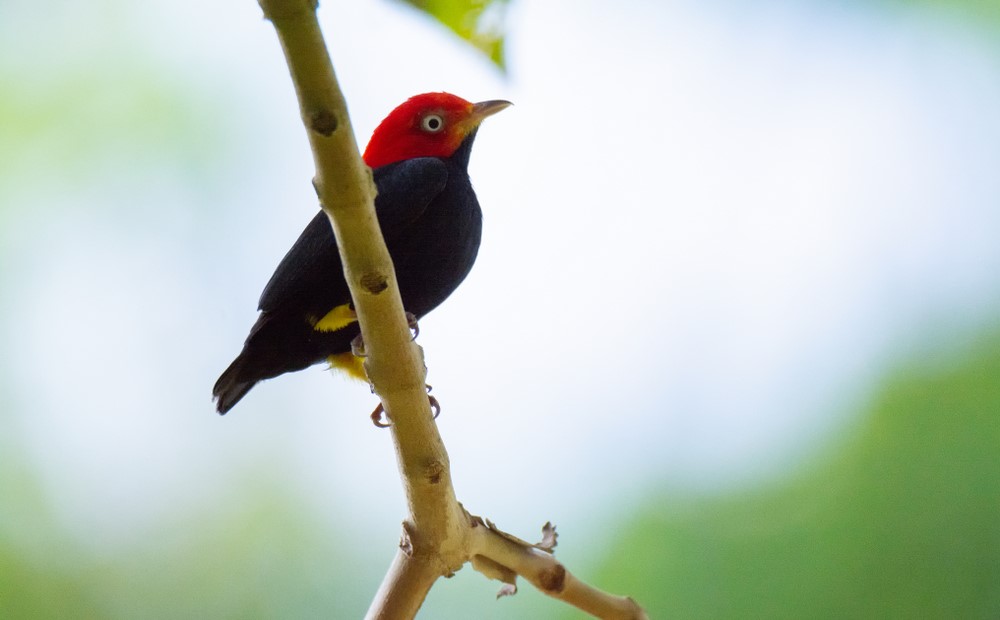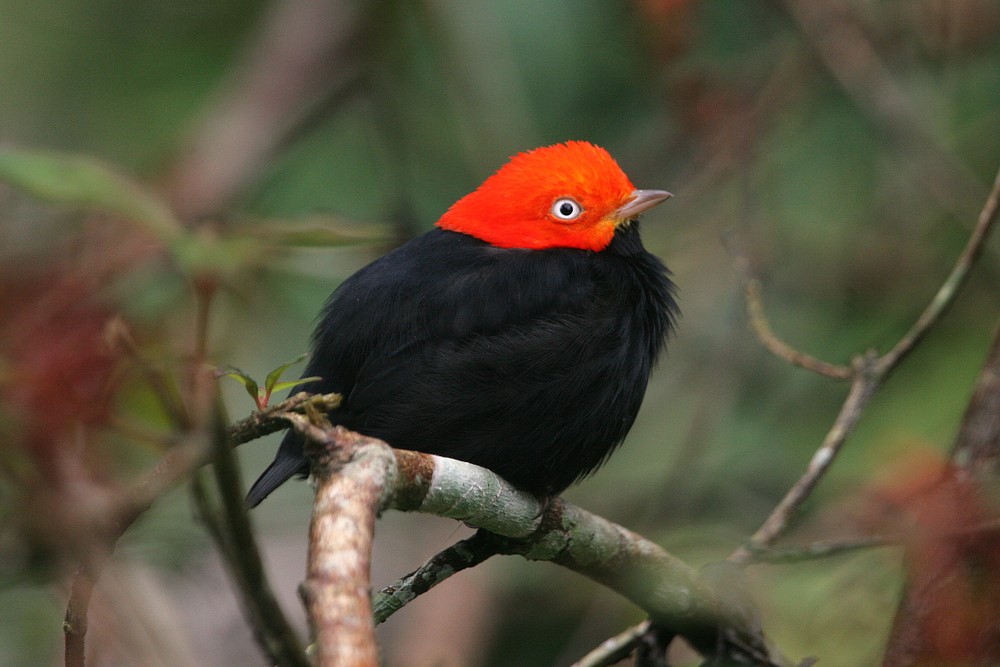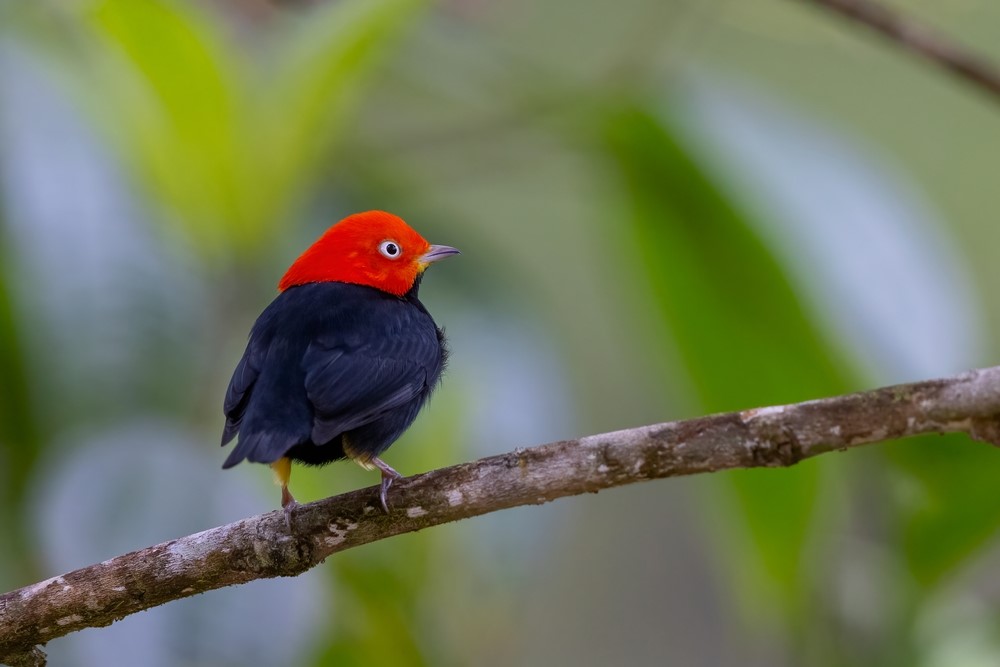The Red-Capped Manakin (Pipra mentalis) is a small, plump passerine bird found in humid evergreen forests of Central and South America. It has an unmistakable appearance with its bright red plumage on the head and upperparts, yellowish belly, and white lower breast and forehead. Males are especially distinct with their short, crest-like crown feathers. This species of Manakin is known for its peculiar mating displays, which involve both aerial and ground movements done in pairs. The Red-Capped Manakin is found in small flocks and tends to make a variety of loud calls throughout the day. They feed mainly on insects but can also eat fruit, nectar and small vertebrates. The species is currently listed as Least Concern by the IUCN Red List of Threatened Species. Conservation efforts to protect their habitat could help ensure their long-term survival in the wild.

Appearance and Behavior
The Red-Capped Manakin has a distinctive appearance, with its bright red plumage on the head and upperparts, yellowish belly, and white lower breast and forehead. Males are especially striking with their short crest-like crown feathers. This species is about 6 inches in length and has a wingspan of eight to nine inches.
This species is known for its peculiar mating displays, which involve both aerial and ground movements done in pairs. They are also active during the day, often seen perching on exposed branches or even making short flights between trees. The Red-Capped Manakin feeds mainly on insects but can also eat fruit, nectar, and small vertebrates. They are often found in small flocks and make a variety of loud calls throughout the day. The species is an overall strong flyer and can easily move between different locations in search of food.
Habitat of Red-Capped Manakin Bird
The Red-Capped Manakin is found in humid evergreen forests of Central and South America, primarily in countries such as Colombia, Costa Rica, Panama and Brazil. They prefer to inhabit dense understory vegetation and can often be found near river edges or other water sources.
The species is not migratory but may move between different areas of its range depending on food availability. The Red-Capped Manakin is a shy bird that is rarely seen by humans due to its dense forest habitat. They are vulnerable to deforestation and other threats such as hunting, nesting habits in the canopy, and competition with other species. Conservation efforts to protect their habitat could help ensure their long-term survival in the wild.

Threats and Conservation
The Red-Capped Manakin is listed as Least Concern by the IUCN Red List of Threatened Species. However, their population is believed to be decreasing due to deforestation, hunting and competition with other species. The species is also vulnerable to natural disasters such as hurricanes, which can cause signficant destruction to its habitat.
Conservation efforts are necessary for the long-term survival of this species. These include protecting their forest habitats from deforestation, providing food and water sources, reducing hunting pressure, and educating local communities about the importance of conserving this bird’s natural environment. Additionally, a monitoring program should be established to track the population of Red-Capped Manakins and assess their conservation status. With concerted efforts, this species can be protected from further decline in its numbers.
Interesting Facts about Red-Capped Manakin Bird
The Red-Capped Manakin has a unique mating behavior that sets it apart from other birds. During the courtship display, two males will perform an elaborate dance in which they move rapidly between branches and leap through the air, accompanied by loud vocalizations. The females typically watch this performance from a distance before selecting one of the males for mating. This species is also known for its bright red plumage, which makes it easy to spot in dense vegetation. Additionally, Red-Capped Manakins often form small flocks in their forest habitat and make a variety of loud calls throughout the day.

Feeding Habits and Diet
The Red-Capped Manakin is an omnivorous species, feeding on a variety of food sources. During the breeding season, they primarily feed on insects such as beetles and grasshoppers. They can also eat fruit, nectar, and small vertebrates such as frogs and lizards. The species is often seen perching in exposed branches or making short flights between trees in search of food.
Overall, the Red-Capped Manakin is a fascinating species with an unmistakable appearance and unique behavior. It has adapted to living in dense forest habitats and can often be seen in small flocks searching for food. With concerted conservation efforts, this species can be protected from further decline in its numbers.
Possible Solutions for Habitat Preservation
Possible solutions for preserving the habitat of the Red-Capped Manakin include creating protected areas, protecting existing forested habitats and restoring degraded forests. Additionally, it is important to reduce hunting and other forms of exploitation that could threaten this species. Education initiatives can also be used to create awareness among local communities about the importance of conserving this bird’s natural environment. Finally, a monitoring program should be established to track the population of Red-Capped Manakins and assess their conservation status. With these efforts in place, the species can be protected from further decline in its numbers.

Red-capped Manakin Birds Dance
The Red-Capped Manakin has an interesting courtship display that sets it apart from other birds. During this dance, two males will move rapidly between branches and leap through the air, accompanied by loud vocalizations. The females typically watch this performance from a distance before selecting one of the males for mating. This behavior is thought to be an adaptation to the dense vegetation of their forest habitat, as it allows them to display their bright red plumage and attract potential mates. With concerted conservation efforts, this species can be protected from further decline in its numbers.
The Red-Capped Manakin is a unique species that deserves attention for its captivating courtship dance and bright red plumage. It is important to take action to protect this bird’s habitat and reduce hunting and other forms of exploitation that could threaten its population. Education initiatives can also be used to create awareness among local communities about the importance of conserving this species’ natural environment.
Red capped manakin bird mating process
The Red-Capped Manakin has a unique mating process that sets it apart from other birds. During the courtship display, two males will perform an elaborate dance in which they move rapidly between branches and leap through the air, accompanied by loud vocalizations. The females typically watch this performance from a distance before selecting one of the males for mating. This behavior is thought to be an adaptation to the dense vegetation of their forest habitat, as it allows them to display their bright red plumage and attract potential mates.
Once a female has chosen a mate, she will typically build a nest in dense vegetation near the nesting territory of the male she chose. The pair will remain monogamous for the duration of the breeding season, and both parents will help build the nest and care for the young. With concerted conservation efforts, this species can be protected from further decline in its numbers.

Conclusion
In conclusion, the Red-Capped Manakin is a fascinating bird with an unmistakable appearance and unique behavior. Its courtship display sets it apart from other species, and its bright red plumage makes it easy to spot in dense forest habitats. It is important to take action to protect this bird’s habitat and reduce hunting and other forms of exploitation that could threaten its population. Education initiatives can also be used to create awareness among local communities about the importance of conserving this species’ natural environment. With concerted conservation efforts, this species can be protected from further decline in its numbers and will remain a beautiful part of our avian world for years to come.
For more information on Red-Capped Manakin facts and conservation status, visit the website of your local wildlife protection organization. Thank you for taking the time to learn more about this unique species!
Read more about Behavior and Habitat of Juvenile Red Tailed Hawks

